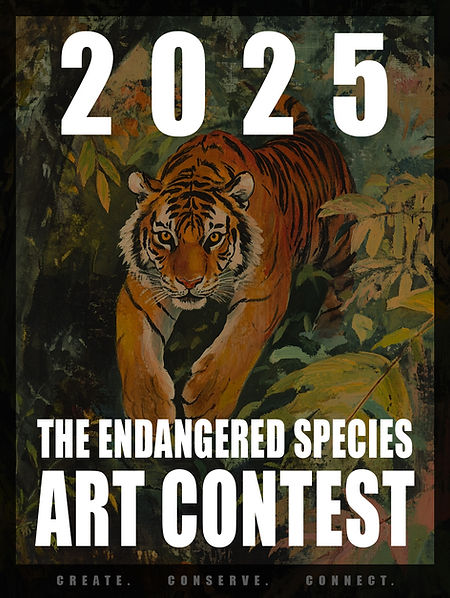
Our Extinction Crisis
.png)
Every day, an estimated 150 to 200 species of plants, insects, birds, and mammals vanish, according to scientists and organizations like the United Nations Environment Programme (UNEP). This equates to one species going extinct every 20 minutes. Current extinction rates are believed to be 1,000 to 10,000 times higher than the natural rate, driven primarily by human activities such as habitat destruction, pollution, overhunting, and climate change. These ongoing losses disrupt ecosystems and endanger biodiversity, which is crucial for sustaining life on Earth.
THE VANISHING POINT:
ENDANGERED SPECIES ART CONTEST

The Vanishing Point invites young artists worldwide to participate in this international competition, dedicated to raising awareness about endangered species. This contest is open to students from kindergarten through 12th grade, including those enrolled in primary or secondary schools or the home-school equivalent. College and university students are not eligible to participate.
Participants will be judged in four grade categories, with 1st, 2nd, and 3rd place winners recognized in each group:
-
Grades K-2
-
Grades 3-5
-
Grades 6-8
-
Grades 9-12
Let your creativity shine while making a difference for endangered species!
The 2025 Vanishing Point Art Contest
*Please review the rules and guidelines thoroughly before entering the competition.

Pongo abelii
The Sumatran orangutan (Pongo abelii) is a critically endangered species found only on Sumatra. These intelligent, arboreal apes play a key role in maintaining the rainforest by dispersing seeds. However, deforestation, palm oil plantations, and illegal hunting have caused their population to drop below 14,000. Urgent conservation efforts are needed to protect them.
Diceros bicornis
The black rhino (Diceros bicornis) is a critically endangered species native to Africa, known for its two horns and hooked lip. Once widespread, their population has dropped to fewer than 5,500 due to poaching and habitat loss. These solitary animals play an important role in their environment, and conservation efforts are vital for their survival.


Loxodonta cyclotis
The African forest elephant (Loxodonta cyclotis) is a smaller, elusive elephant species native to the dense forests of Central and West Africa. Recognized by its straighter tusks and rounded ears, it plays a vital role in seed dispersal and forest regeneration. Severe threats from poaching and habitat loss have caused drastic population declines, making conservation efforts essential for its survival.
Panthera tigris altaica
The Siberian tiger (Panthera tigris altaica), also known as the Amur tiger, is the largest cat species in the world, native to the forests of eastern Russia and parts of China. Known for its thick fur and pale orange coat with dark stripes, it is adapted to harsh, snowy environments. Despite conservation efforts, the Siberian tiger remains endangered due to poaching and habitat loss. As a top predator, it plays a critical role in maintaining the balance of its ecosystem, making its protection vital for the health of its habitat.


Gymnogyps californianus
The California condor (Gymnogyps californianus) is North America’s largest flying bird, with a wingspan of up to 10 feet. This critically endangered scavenger plays a vital role in ecosystems by feeding on carrion. Once nearly extinct, conservation efforts have helped its recovery, but it remains threatened by lead poisoning and habitat loss.
Panthera uncia
The snow leopard (Panthera uncia) is a solitary and elusive big cat native to the mountainous regions of Central and South Asia. Known for its thick, smoky-gray fur and long tail, it is perfectly adapted to cold, rugged environments. As a vulnerable species, it faces threats from poaching, habitat loss, and declining prey. Snow leopards play a crucial role as top predators, maintaining the balance of their fragile ecosystems.


Gorilla gorilla gorilla
The western lowland gorilla (Gorilla gorilla gorilla) is the smallest and most widespread gorilla subspecies, found in the dense forests of Central Africa. Known for its stocky build and gentle demeanor, it plays a key role in seed dispersal, supporting forest ecosystems. Despite its adaptability, the species is critically endangered due to poaching, habitat loss, and disease, making conservation efforts essential for its survival.



